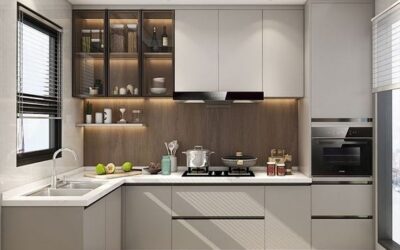Upholstery refers to the materials, often fabrics, that are used to cover and pad furniture, such as sofas, chairs, and other seating pieces. It is a crucial element of interior design, contributing to the overall aesthetics, comfort, and functionality of a space. Upholstery involves the process of providing furniture with padding, springs, webbing, and fabric or leather covers.
Fabrics in interiors, on the other hand, extend beyond upholstery to include a wide range of materials used for various purposes, such as curtains, drapes, bedding, cushions, and decorative textiles. Fabrics are essential for adding texture, color, and personality to a space. They can be made from natural fibers (such as cotton, linen, wool, and silk), synthetic materials (like polyester and nylon), or a blend of both.
Considerations when it comes to upholstery and fabrics
1.Material Selection:
- Natural Fabrics: Materials like cotton, linen, wool, and silk offer a comfortable and breathable feel. They are versatile and can be used in various settings.
- Synthetic Fabrics: Fabrics like polyester, microfiber, and nylon are durable, resistant to stains, and often more affordable than natural fibers.
- Leather: A timeless and luxurious choice, leather adds sophistication to a space. It’s durable and can develop a rich patina over time.
2.Durability:
- Consider the level of durability needed for the specific piece of furniture or space. For high-traffic areas, opt for durable and stain-resistant fabrics.
- Assess the durability of the fabric. Look for fabrics with high abrasion resistance, especially for frequently used furniture.
- Consider the Martindale rub test rating, which measures a fabric’s resistance to wear and abrasion.
3.Color and Pattern:
- Choose colors and patterns that complement the overall design theme of the space. Consider the size of the room and how patterns will interact with other design elements.
- Consider the color scheme of the room and choose upholstery that complements or contrasts with the existing colors.
- Take into account the size of the furniture and the scale of the patterns. Large patterns may overpower small furniture, and vice versa.
4.Texture:
-
Incorporate a variety of textures to add depth and visual interest. Mix smooth, plush fabrics with more textured ones to create a dynamic and inviting atmosphere.
- Consider how the fabric feels to the touch. Some people prefer the softness of plush fabrics, while others may prefer the smoothness of silk or the texture of a nubby fabric.
- Visual texture is the perceived texture of a fabric based on its appearance rather than its feel. Different weaves, patterns, and finishes can contribute to visual texture.
5.Cleaning and Maintenance:
- Consider the ease of maintenance and cleaning for the chosen fabrics. Some materials are more resistant to stains and easier to clean than others.
- Evaluate the ease of cleaning. Some fabrics are more stain-resistant and easier to clean than others.
- Check the manufacturer’s recommendations for cleaning and maintenance, and choose fabrics that align with your willingness and ability to maintain them.
6.Functionality:
-
Think about the purpose of the furniture or space. For example, a family room sofa may require a more durable and stain-resistant fabric compared to a decorative accent chair.
- Fabrics treated with stain-resistant finishes or inherently resistant to spills may be ideal for households with children or pets.
- If the furniture will be exposed to sunlight, consider fabrics that resist fading. This is especially important for pieces placed near windows.
7.Contrast and Coordination:
-
Use upholstery to create contrast or coordination with other elements in the room. It could match or complement the color scheme of walls, flooring, or other furniture pieces.
- Use contrasting colors to create visual interest. For example, pairing a light-colored sofa with dark-colored throw pillows or vice versa can make each element stand out.
- Ensure that the color palette of different fabrics coordinates harmoniously. You can use a consistent color scheme or complementary colors to tie various elements together.
8.Style and Aesthetics:
- Choose fabrics that align with the overall design style of the space. Consider the color, pattern, and texture to create a cohesive and visually appealing look.
- Ensure that the fabric aligns with the overall style and theme of the room. Different fabrics convey different aesthetics, from casual to formal.
- Think about the texture of the fabric and how it contributes to the overall look and feel of the space.
9.Scale and Proportion:
-
Consider the scale and proportion of the furniture in relation to the space. Larger patterns or bold colors can make a statement, but they should not overpower the room if it’s smaller in size.
- Choose upholstery fabrics that are proportionate to the size of the furniture. Large patterns may overwhelm small pieces, while small patterns on large furniture may get lost.
- Ensure that the proportions of the upholstery match the overall proportions of the furniture. For example, a high-back sofa may look more balanced with substantial, well-proportioned upholstery.
10.Customization:
- Explore custom upholstery options to tailor furniture pieces to your specific design vision. Customization allows you to choose the exact fabric, color, and details to match your style.
- Choose the base material for upholstery based on preferences for comfort, durability, and aesthetics. Common choices include fabrics (cotton, linen, wool, etc.), leather, and synthetic materials.
- Look for customization options that provide adjustable features, such as reclining sections, adjustable headrests, or convertible sofa beds.
11.Seasonal Considerations:
- In some cases, you might want to consider the seasonality of fabrics. Lighter, breathable fabrics like linen work well in summer, while heavier, warmer fabrics like wool or velvet are suitable for winter.
- Consider the climate of the area. In humid environments, mold and mildew resistance may be important.
- If the furniture will be placed near windows, consider fabrics that resist fading from sunlight.
12.Environmental Impact:
-
Consider the environmental impact of the fabrics. Sustainable and eco-friendly options, such as organic cotton or recycled materials, are increasingly popular in interior design.
- Consider the environmental impact of the fabrics. Some materials may be more sustainable and eco-friendly than others.
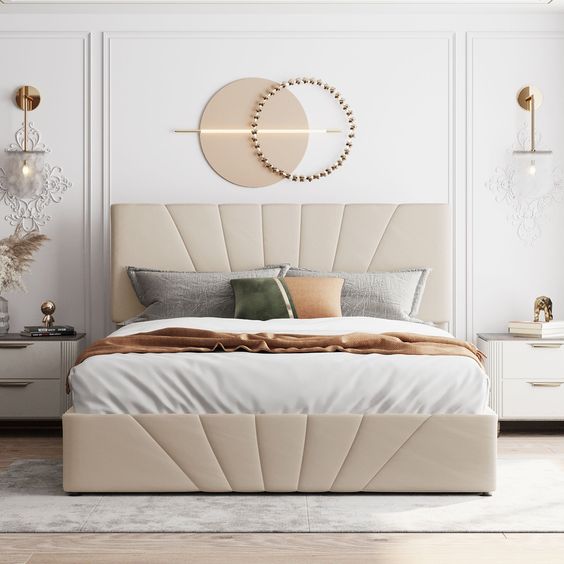
Source: overstock.com
Most commonly used Upholstery and fabrics in interiors
Get Free Design
1.Cotton:
- Cotton is a natural fiber that is breathable, comfortable, and easy to clean.
- It comes in a variety of weaves and finishes, making it suitable for different furniture styles.
- Properties: Soft, breathable, and comfortable. Available in various weaves and patterns.
- Uses: Upholstery, slipcovers, drapery, and bedding.
- Considerations: Prone to wrinkling and may not be as stain-resistant as some other fabrics.
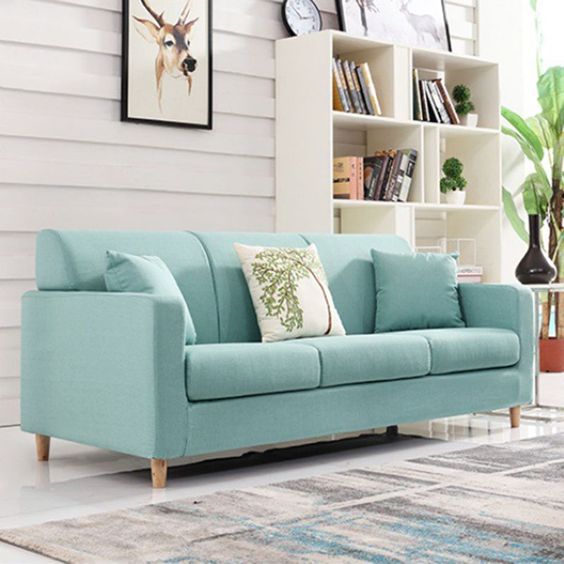
Source: createwhite.com
2.Linen:
- Linen is a natural fiber known for its casual and relaxed appearance.
- It has a textured look and tends to wrinkle easily, giving furniture a laid-back and inviting feel.
- Properties: Natural, breathable, and has a textured appearance. It can have a slightly more casual look.
- Uses: Upholstery, drapery, and casual furniture.
- Considerations: Wrinkles easily but is generally durable.
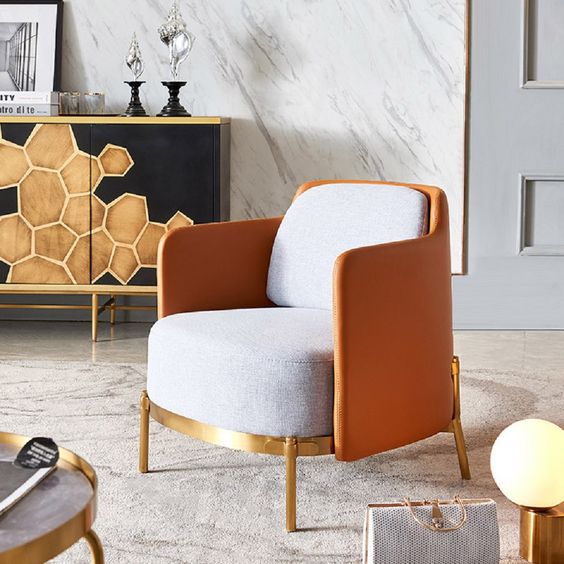
Source: es.homary.com
3.Polyester:
- Polyester is a synthetic fabric that is durable, resistant to wrinkles, and easy to maintain.
- It is often blended with other fibers to enhance its performance and feel.
- Properties: Durable, resistant to wrinkles and fading. Often blended with other fibers.
- Uses: Versatile for upholstery, drapery, and accent pieces.
- Considerations: Affordable and comes in a variety of textures and patterns
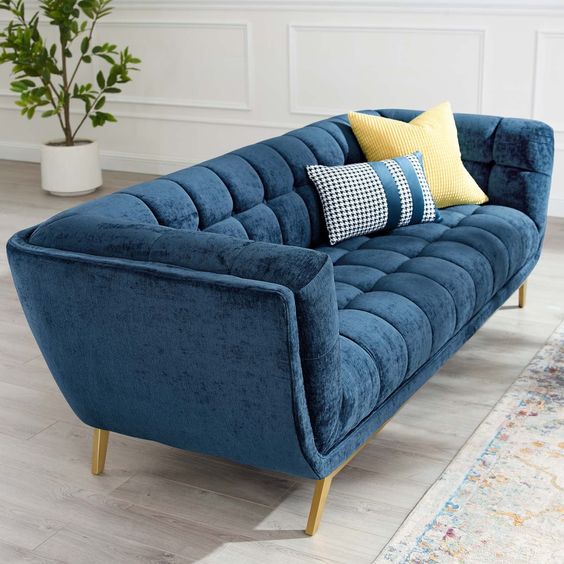
Source: casaone.com
4.Microfiber:
- Microfiber is a synthetic material with a soft and suede-like texture.
- It is stain-resistant, making it a popular choice for furniture in households with children or pets.
- Properties: Soft, durable, and resistant to stains. Often mimics the feel of suede.
- Uses: Upholstery, sofas, and chairs.
- Considerations: Easy to clean and maintain.
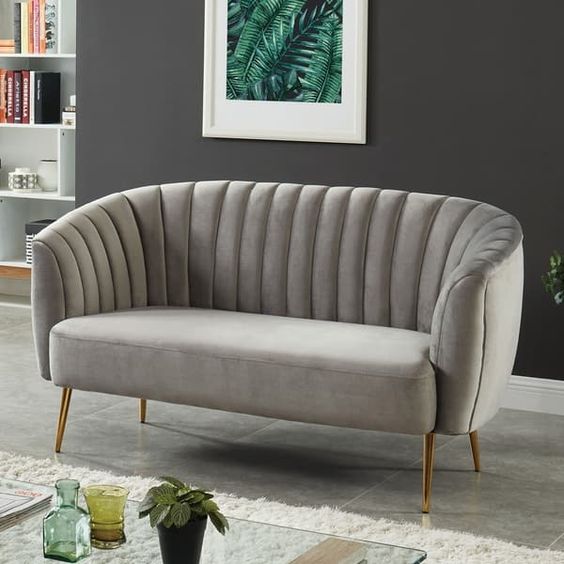
Source: overstock.com
5.Wool:
- Wool is a natural fiber known for its warmth and luxurious feel.
- It is durable and resistant to wrinkling, making it suitable for upholstery in various settings.
- Properties: Luxurious, durable, and naturally resistant to stains and wrinkles.
- Uses: Upholstery, rugs, and drapery.
- Considerations: Can be more expensive, but it is known for its longevity and high-quality feel.
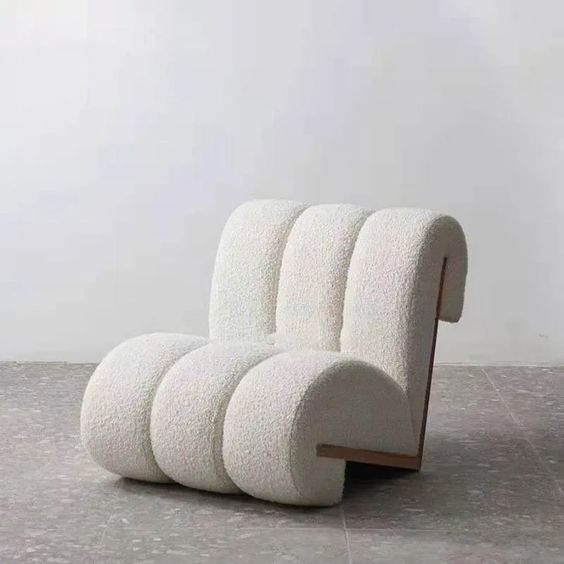
Source: lovedecors.com
6.Velvet:
- Velvet is a plush and luxurious fabric with a soft pile.
- It adds a touch of elegance and sophistication to furniture, often used in formal or statement pieces.
- Properties: Luxurious, soft, and has a plush texture. Adds a touch of elegance.
- Uses: Upholstery, accent pieces, and drapery.
- Considerations: Shows wear over time, and some varieties may be more challenging to clean.
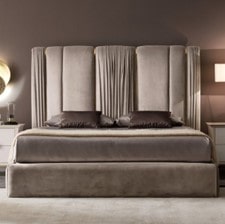
Source: juliettes.interiors.com
7.Leather:
- Leather is a durable and classic upholstery material that ages well.
- It can have a polished or distressed look, offering versatility in design styles.
- Properties: Durable, luxurious, and easy to clean. Develops a patina over time.
- Uses: Upholstery, sofas, chairs, and accent pieces.
- Considerations: Comes in various grades, with top-grain leather being the highest quality.
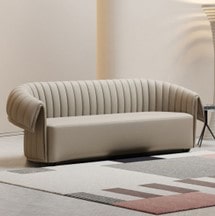
Source: Fr.homary.com
8.Canvas:
- Canvas is a sturdy and durable fabric often used for casual and outdoor furniture.
- It can be treated for water resistance, making it suitable for various environments.
- Properties: durability, making it suitable for upholstery in high-traffic areas.
- Uses: outdoor upholstery
- Considerations: involve vacuuming or brushing to remove dust and debris.
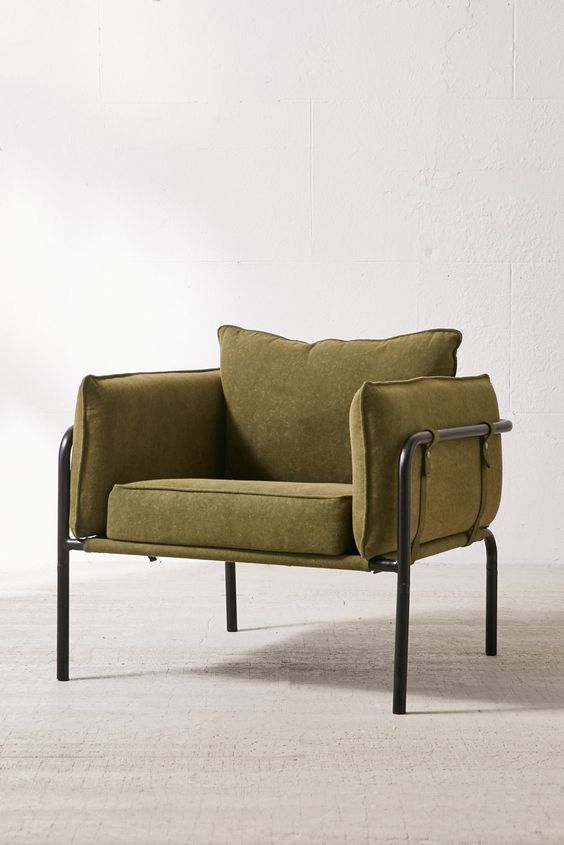
Source: Urban Outfitters
9.Sunbrella:
- Sunbrella is a brand known for its performance fabrics designed for outdoor use.
- It is resistant to fading, stains, and mildew, making it ideal for patio furniture.
- Properties: Highly durable, fade-resistant, and water-resistant. Designed for outdoor use.
- Uses: Outdoor furniture, cushions, and pillows.
- Considerations: Ideal for withstanding exposure to the elements.
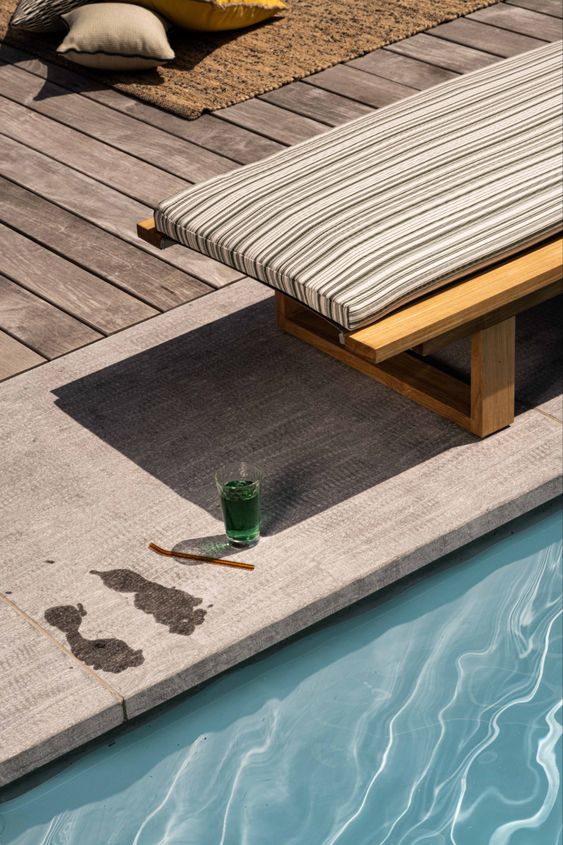
Source: global.sunbrella.com
10.Chenille:
- Chenille is a soft and textured fabric that adds warmth and coziness to furniture.
- It is commonly used for upholstery in living spaces and bedrooms.
- Properties: Soft, plush, and has a velvety texture. Offers a cozy feel.
- Uses: Upholstery, throw pillows, and blankets.
- Considerations: Can be challenging to clean, and the texture may flatten over time.
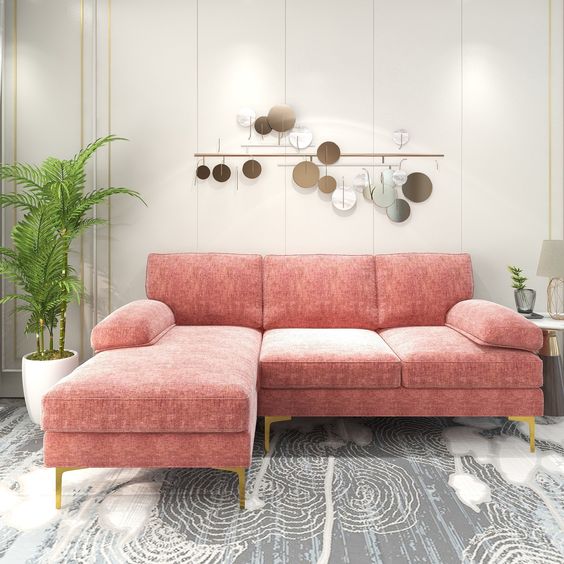
Source: bedbathandbeyond.com
10.Jacquard:
- Jacquard fabrics feature intricate patterns woven into the fabric, creating a luxurious and textured look.
- They are often used for statement pieces or accent furniture.
- Properties: Highly durable, fade-resistant, and water-resistant. Designed for outdoor use.
- Uses: sofas and chairs to ottomans and cushions.
- Considerations: breathable, contribute to comfort, slightly coarse texture.
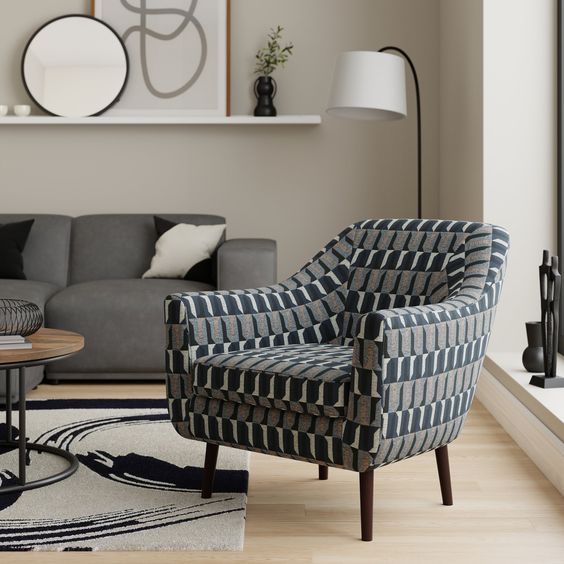
Source: dunelm.com
Texture Considerations in Upholstery and Fabrics
Texture is a crucial element in upholstery and fabrics, playing a significant role in the overall aesthetics and comfort of your living space. When considering texture, it involves both the visual and tactile aspects of the fabric. Here are key considerations for texture in upholstery and fabrics:
1. Tactile Feel: The Touch Experience
- Softness vs. Roughness: Consider the tactile feel of the fabric. Some fabrics, like velvet or chenille, are known for their softness, while others, like canvas or burlap, may have a rougher texture.
- Comfort Level: Evaluate the comfort level of the fabric, especially for furniture where touch is a key factor. A balance between softness and durability is often sought.
2. Visual Texture: Adding Depth to Design
- Patterns and Weaves: The visual texture created by patterns and weaves contributes to the overall design. Jacquard, damask, and herringbone patterns, for example, can add depth and interest.
- Embossing and Printing: Some fabrics feature embossed patterns or printed textures, providing a visual appeal that mimics the look of certain materials, such as leather or reptile skin.
3. Scale of Patterns: Creating Visual Interest
- Large vs. Small Patterns: Consider the scale of patterns in relation to the size of the furniture and the room. Large patterns can make a bold statement, while smaller patterns may offer subtlety.
- Mixing Patterns: Experiment with mixing patterns of different scales to create visual interest. However, maintain a sense of balance to avoid overwhelming the space.
4. Contrast and Balance: Aesthetic Harmony
- Contrast for Emphasis: Use texture contrast to emphasize certain elements in the room. For instance, a textured accent chair can stand out against smoother upholstery.
- Balancing Textures: Ensure a harmonious balance between different textures. If the upholstery is plush, consider pairing it with a smooth and sleek coffee table or vice versa.
5. Practicality and Maintenance: Ensuring Longevity
- Ease of Cleaning: Consider the practicality of maintaining the fabric’s texture. Smooth, tightly woven fabrics are often easier to clean than textured or nubby fabrics that can trap dirt.
- Longevity of Texture: Some textured fabrics may flatten or change over time. Choose textures that maintain their appearance and integrity through regular use and cleaning.
6. Color and Pattern: Enhancing the Visual Appeal
- Color Impact on Texture: The color of the fabric can influence how texture is perceived. Darker colors may emphasize texture, while lighter colors may soften it.
- Texture as a Design Element: Use texture as a deliberate design element. For example, a neutral room can be brought to life with the addition of textured fabrics in various shades.
7. Material-Specific Considerations:
- Leather Texture: Leather offers a unique texture that develops a patina over time. Consider whether you prefer the smoothness of new leather or the character that comes with aging.
- Linen and Cotton: Natural fibers like linen and cotton often have a textured appearance. Linen, in particular, may have a slightly coarse feel, adding a rustic touch.
8. Pattern Coordination:
- Coordination with Other Patterns: If you have multiple patterns in a room, coordinate the textures within those patterns. For instance, if you have a floral pattern, pair it with a solid or subtly textured fabric.
9. Comfort and Coziness:
- Plush Fabrics: Plush and velvety textures contribute to a sense of comfort and coziness. Consider using these textures in areas where relaxation is a priority, such as a reading nook or bedroom.
10. Visual Flow:
- Consistency in Texture Flow: Maintain a visual flow by ensuring that the textures used in upholstery complement each other. Consistency creates a cohesive and well-designed space.
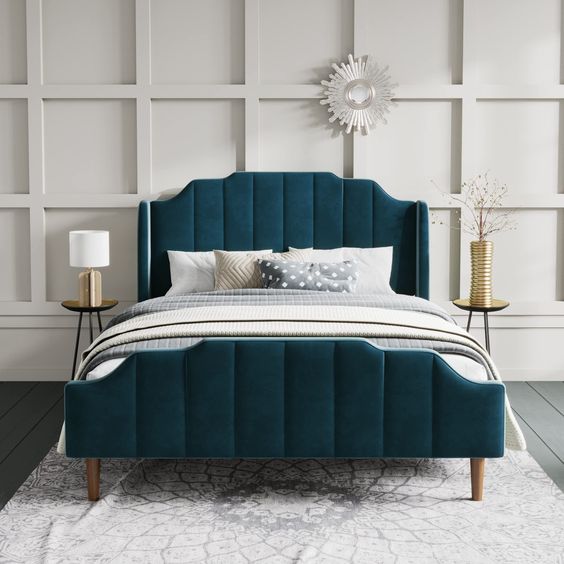
Source: amazon.com
Conclusion
Upholstery and fabrics are the unsung heroes of interior design, shaping the character and functionality of our living spaces. Whether you opt for classic jacquard upholstery, explore modern synthetic blends, or embrace the natural beauty of materials like linen and leather, the choices you make contribute to the story your home tells. By understanding the nuances of texture, considering functionality, and embracing customization options, you can create a space that not only reflects your style but also enhances your daily living experience. Upholstery and fabrics are the threads that weave comfort, beauty, and functionality into the tapestry of your home.

About Author ankitha kelkar
You May Also Like…
The Ultimate Guide to Small Modular Kitchen Designs in 2024
A brief overview of Small Modular Kitchen DesignThe space...
Top 10 TV Unit Designs to Enhance Your Home Interiors
Television unit designs have changed in response to changing...


